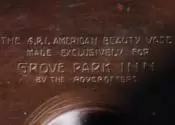A Roycroft American Beauty Vase – And a GPI Honeymoon?

Inspired by the American Beauty rose and, perhaps, by the 1913 hit ragtime melody “American Beauty Rag” composed by Joseph Lamp, a student of Scott Joplin, the Roycroft Copper Shop produced four different sizes of a hammered copper vase called the American Beauty vase.
The vases ranged in size from a diminutive seven inches to a stately 22″ beauty with a special inscription. Their design has been credited to Victor Toothaker, who was hired in 1912 as the chief designer and foreman after the abrupt departure of both Karl Kipp and Walter Jennings, reportedly over a wage dispute with Alice and Elbert Hubbard. Each version features a bulbous base supporting a tall, slender neck before flaring out at the top. Most were produced in either the dark Aurora Brown finish or a lighter Old Brass.
The seven-inch version does not appear often, yet fails to generate much excitement beyond the diehard Roycroft collectors who want one of each size in their collection. It and the twelve-inch version suffer from the same design flaw: the tall, slender shaft seems too small for the bulbous base. Nevertheless, they both seem to sell in the $1500-$2000 range when in perfect condition and in the darker Aurora Brown finish.
The third version ranges in size from 18″ to 19.5″ and is the most common (pictured). The subtle differences in both height and design are attributed to the fact that these vases were made by different craftsmen from around 1913 until demand for hand-hammered copper wares began to decrease significantly in the 1920s. Designer Victor Toothaker appears to have left around 1915, about the time that Elbert Hubbard perished aboard the Lusitania, and Karl Kipp and Walter Jennings returned to the Roycroft Copper Shop.
In 1913 the Grove Park Inn began ordering a special commission: a 21″ vase with a stamped special inscription: “The G.P.I. American Beauty Vase Made Exclusively For Grove Park Inn by The Roycrofters.” Some vases also exhibit the traditional Roycroft orb-and-cross mark below the inscription. These vases were both used by and sold at the Grove Park Inn, but their price of ten dollars (the same as a piece of Arts & Crafts furniture) may have hindered their sales and their production, for this version is the rarest of the entire set.
One example of the Grove Park Inn American Beauty vase surfaced recently bearing an additional inscription. On the bulbous base, just below the junction with the shaft, appears the following in a non-Arts & Crafts font: “G.P.I. 1919.” The inscription inspires speculation: what event motivated someone to immortalize it with an engraving? A major anniversary generally includes a beginning date, such as 1894-1919. A wedding often includes a reference to a specific day, such as October 31, 1919.
But an extended stay, such as a honeymoon at the famed Grove Park Inn, might just be remembered with the letters G.P.I. and the year 1919. One can easily imagine a young couple, perhaps the groom being a soldier recently home from the war, who honeymooned at the Grove Park Inn and who splurged, using some of their wedding cash, to buy a tall, beautiful Roycroft vase as a lasting memento of their special time together in Asheville.
To a hopeless romantic, it certainly sounds plausible.
And why not?
– Bruce Johnson

